Levels of arsenic, copper and zinc have been found in the Ōhinemuri River in Karangahake Gorge after it turned bright orange.
Waikato Regional Council confirmed preliminary results on Tuesday from sampling conducted after the river turned bright orange on Friday.
Elevated arsenic levels had been detected in the discharged sediment, while the arsenic content present in the water was within drinking water and ecological protection guidelines for freshwater, the council said on Tuesday.
Council staff were still investigating the cause of the incident and had been taking samples of the sediment and affected waterways on Friday, Saturday and Monday.
The council said it was testing for 33 heavy metals and so far only had half the results.
The results showed there were also elevated levels of copper and zinc, similar to what could be seen in urban stormwater.
High levels of iron in the sediment accounted for the bright orange colour.
Environmental chemistry senior scientist Jonathan Caldwell says the results indicate arsenic is likely to be in a mineralised and bound-up form with the orange-coloured iron-containing sediments that were so visible in the river.
In this form it posed less immediate risk to fish in the water but could still pose longer-term risk in downstream areas where sediments accumulated, he says.
“So far, the preliminary sampling results have not detected the presence of cyanide, which was often used to help separate the gold and silver from the mined materials,” says Jonathan.
“The results also show that the water was not very acidic, which also reduces the concern around short-term effects on fish.”
Results regarding downstream samples in the main stem of the river were yet to be received and would provide a fuller picture of the potential effects, the council said.
 Waikato Regional Council is urging people to treat the discolouration of the Ōhinemuri River as contamination. Photo: Davidda Hikatangata.
Waikato Regional Council is urging people to treat the discolouration of the Ōhinemuri River as contamination. Photo: Davidda Hikatangata.
On Friday, Waikato Regional Council urged people to treat bright-orange discolouration in the river as contaminated after sediment was discharged from a historic mine shaft in the Karangahake Gorge.
Regional compliance manager Patrick Lynch says since Saturday, when staff confirmed the source of the sediment, a lot more sediment had moved from the front of the mine shaft into the stream that connected with the river.
“There is still more sediment coming out, and if we get more rain then we can expect to see more orange plumes in the river; it’s quite obvious that a lot of people have been coming here and entering the mine.
“This area is very hazardous, and we’ve asked the Department of Conservation as the landowner to consider some specific signage about entering the mine and perhaps securing the front of the mine shaft.”
Patrick says there is no evidence to suggest the build-up of the sediment was due to a man-made structure, and it appears the water leaving the mine was cutting its own natural channel, which was much deeper yesterday than it had been on Saturday.



1 comment
So what about upstream ?
Posted on 27-08-2024 11:39 | By an_alias
So what are the base levels from up stream ?
Your giving us ZERO details to compare to, I mean that makes all of your points useless.
I mean all your saying is we have Iron in the water, we can already see that from the color.
Leave a Comment
You must be logged in to make a comment.